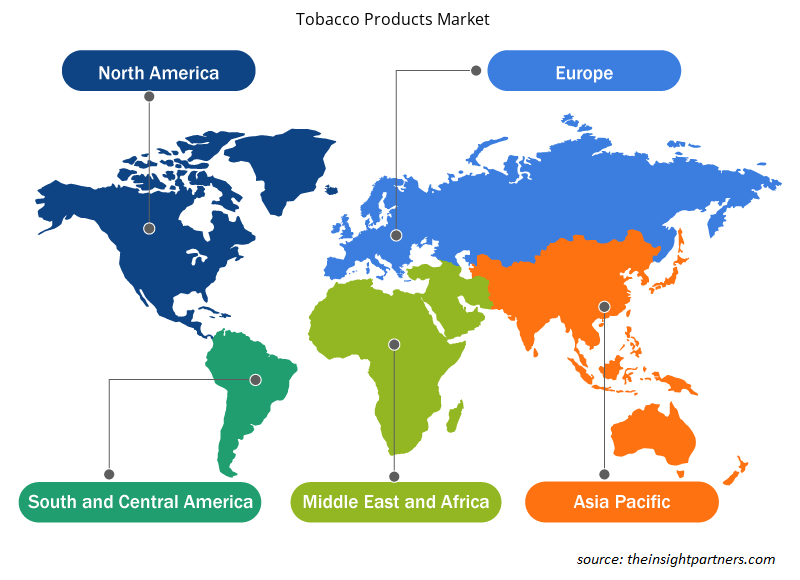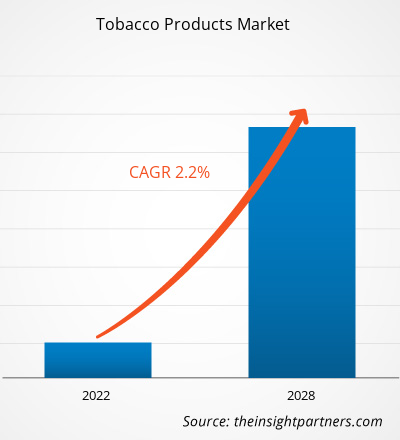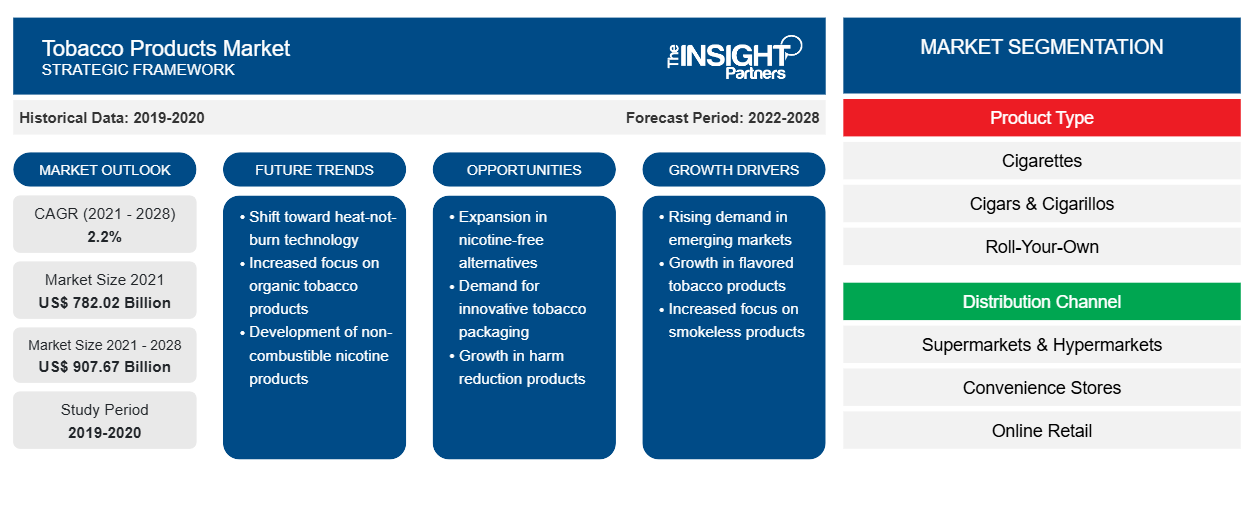Si prevede che il mercato dei prodotti del tabacco raggiungerà i 907.665,43 milioni di dollari entro il 2028, rispetto ai 782.022,19 milioni di dollari del 2021. Si prevede che crescerà a un CAGR del 2,2% dal 2021 al 2028.
Le foglie di tabacco di diverse varietà, come Virginia e Burley , vengono miscelate per produrre prodotti come sigarette , sigari e sigarilli e tabacco da arrotolare. Il consumo di tabacco e prodotti correlati è aumentato in tutto il mondo durante il periodo di rallentamento economico a causa del calo dei mercati azionari e delle esecuzioni immobiliari, e dello stress correlato ai licenziamenti, che ha spinto molte persone a cercare rifugio nel fumo. Il tabacco è una delle sostanze che creano dipendenza più comuni utilizzate al mondo. Contribuisce inoltre alla maggior parte delle entrate fiscali per varie nazioni nelle economie sviluppate e in via di sviluppo.
L'Asia-Pacifico ha detenuto la quota maggiore del mercato dei prodotti del tabacco nel 2020, mentre si prevede che il Medio Oriente e l'Africa registreranno un CAGR significativo nel mercato durante il periodo di previsione. I principali attori che operano nel mercato dei prodotti del tabacco stanno espandendo le loro operazioni in Medio Oriente e Africa grazie alla potenziale base di clienti, alle leggi favorevoli e al panorama della vendita al dettaglio in rapida evoluzione in tutta la regione.
Personalizza questo report in base alle tue esigenze
Riceverai la personalizzazione gratuita di qualsiasi report, comprese parti di questo report, o analisi a livello nazionale, pacchetto dati Excel, oltre a usufruire di grandi offerte e sconti per start-up e università
-
Scopri le principali tendenze di mercato in questo rapporto.Questo campione GRATUITO includerà analisi di dati che spaziano dalle tendenze di mercato alle stime e alle previsioni.
Impatto della pandemia di COVID-19 sul mercato dei prodotti del tabacco
La pandemia di COVID-19 ha portato sfide senza precedenti per molti settori all'inizio del 2020. Lockdown , restrizioni alle frontiere, divieti di viaggio, interruzione della produzione e altre misure di sicurezza implementate dai governi secondo le linee guida dell'OMS e dei ministeri della salute nazionali hanno ostacolato le operazioni di produzione. D'altro canto, secondo gli studi condotti dall'American College of Physicians, durante i primi 16 mesi della pandemia di COVID-19, le vendite di sigarette negli Stati Uniti sono state maggiori del previsto. La maggior parte delle aziende produttrici di tabacco ha assistito a un'impennata della domanda di prodotti del tabacco senza fumo o riscaldati e di prodotti del tabacco da masticare durante la pandemia. Tuttavia, hanno dovuto affrontare un leggero calo delle vendite al dettaglio di viaggi a causa dei divieti di viaggio.
Approfondimenti di mercato
La crescente domanda di prodotti del tabacco non combustibili stimola la crescita del mercato
A causa delle crescenti preoccupazioni per la salute legate al consumo di prodotti del tabacco combustibili, i governi hanno incoraggiato le aziende a introdurre diverse leggi e normative per tenere sotto controllo il consumo di tabacco. Hanno aumentato le tasse sul tabacco combustibile e abbassato i prezzi del tabacco non combustibile. Ciò ha portato a una maggiore adozione di prodotti non combustibili, come le sigarette elettroniche. Ad esempio, il governo del Regno Unito ha adottato un approccio olistico aumentando significativamente le tasse sui prodotti del tabacco combustibili e abbassando le tasse sui prodotti non combustibili. Ciò ha aumentato l'adozione delle sigarette elettroniche nel mercato del Regno Unito, riducendo significativamente i tassi di prevalenza del fumo nel paese. I produttori hanno anche sviluppato prodotti del tabacco orale, non combustibile o senza fumo nella categoria dei prodotti a rischio ridotto ( RRP ).
Informazioni sul tipo di prodotto
In base al tipo di prodotto, il mercato dei prodotti del tabacco è suddiviso in sigarette, sigari e sigarilli, roll-your-own e altri. Si prevede che il segmento degli altri prodotti del tabacco registrerà il CAGR più elevato durante il periodo di previsione. Questo segmento include sigarette elettroniche, vaporizzatori, snus e solubili. La crescente consapevolezza dei danni causati dai prodotti del tabacco combustibili sta guidando la domanda di prodotti del tabacco non combustibili, come sigarette elettroniche, vaporizzatori e prodotti del tabacco da masticare.
Informazioni sui canali di distribuzione
In base al canale di distribuzione, il mercato dei prodotti del tabacco è stato segmentato in supermercati e ipermercati, minimarket, vendita al dettaglio online e altri. Si prevede che il segmento della vendita al dettaglio online registrerà il CAGR più elevato nel mercato durante il periodo di previsione. La vendita al dettaglio online offre agli utenti un'esperienza di acquisto comoda, seguita da una consegna semplificata dei prodotti. I negozi al dettaglio online offrono un'ampia gamma di prodotti con forti sconti; inoltre, i consumatori possono comodamente acquistare prodotti desiderabili da remoto. I servizi di consegna a domicilio incoraggiano un gran numero di consumatori ad acquistare tramite portali di e-commerce.
I principali attori che operano nel mercato dei prodotti del tabacco includono Altria Group, Inc.; British American Tobacco plc; Swedish Match AB; ITC Ltd.; Japan Tobacco International; Imperial Brands; Philip Morris Products SA; Vector Group LTD.; Pyxus International, Inc.; e China Tobacco International (HK) Company Limited. Questi attori sono impegnati nello sviluppo di prodotti con rischi per la salute ridotti per soddisfare le tendenze emergenti dei consumatori, oltre a rispettare i quadri normativi. Sono coinvolti in fusioni e acquisizioni, espansioni aziendali e partnership per espandere la loro quota di mercato.
Approfondimenti regionali sul mercato dei prodotti del tabacco
Le tendenze regionali e i fattori che influenzano il mercato dei prodotti del tabacco durante il periodo di previsione sono stati ampiamente spiegati dagli analisti di Insight Partners. Questa sezione discute anche i segmenti e la geografia del mercato dei prodotti del tabacco in Nord America, Europa, Asia Pacifico, Medio Oriente e Africa e America meridionale e centrale.

- Ottieni i dati specifici regionali per il mercato dei prodotti del tabacco
Ambito del rapporto sul mercato dei prodotti del tabacco
| Attributo del report | Dettagli |
|---|---|
| Dimensioni del mercato nel 2021 | 782,02 miliardi di dollari USA |
| Dimensioni del mercato entro il 2028 | 907,67 miliardi di dollari USA |
| CAGR globale (2021 - 2028) | 2,2% |
| Dati storici | 2019-2020 |
| Periodo di previsione | 2022-2028 |
| Segmenti coperti |
Per tipo di prodotto
|
| Regioni e Paesi coperti |
America del Nord
|
| Leader di mercato e profili aziendali chiave |
|
Densità degli attori del mercato dei prodotti del tabacco: comprendere il suo impatto sulle dinamiche aziendali
Il mercato dei prodotti del tabacco sta crescendo rapidamente, spinto dalla crescente domanda degli utenti finali dovuta a fattori quali l'evoluzione delle preferenze dei consumatori, i progressi tecnologici e una maggiore consapevolezza dei benefici del prodotto. Con l'aumento della domanda, le aziende stanno ampliando le loro offerte, innovando per soddisfare le esigenze dei consumatori e capitalizzando sulle tendenze emergenti, il che alimenta ulteriormente la crescita del mercato.
La densità degli operatori di mercato si riferisce alla distribuzione di aziende o società che operano in un particolare mercato o settore. Indica quanti concorrenti (operatori di mercato) sono presenti in un dato spazio di mercato in relazione alle sue dimensioni o al valore di mercato totale.
Le principali aziende che operano nel mercato dei prodotti del tabacco sono:
- Altria Group, Inc.
- Società per azioni British American Tobacco plc.
- Partita svedese AB
- Società anonima ITC Ltd.
- Tabacco del Giappone Internazionale
Disclaimer : le aziende elencate sopra non sono classificate secondo un ordine particolare.

- Ottieni una panoramica dei principali attori del mercato dei prodotti del tabacco
Segnala i riflettori
- Tendenze industriali progressive nel mercato dei prodotti del tabacco per aiutare gli operatori a sviluppare strategie efficaci a lungo termine
- Strategie di crescita aziendale adottate per garantire la crescita nei mercati sviluppati e in via di sviluppo
- Analisi quantitativa del mercato dei prodotti del tabacco dal 2019 al 2028
- Stima della domanda globale di prodotti del tabacco
- Analisi delle cinque forze di Porter per illustrare l'efficacia degli acquirenti e dei fornitori che operano nel settore
- Sviluppi recenti per comprendere lo scenario competitivo del mercato
- Tendenze e prospettive del mercato, nonché fattori che regolano la crescita del mercato dei prodotti del tabacco
- Assistenza nel processo decisionale evidenziando le strategie di mercato che sostengono l'interesse commerciale, portando alla crescita del mercato
- Dimensioni del mercato dei prodotti del tabacco in vari nodi
- Panoramica dettagliata e segmentazione del mercato e dinamiche del settore del tabacco
- Dimensioni della crescita in diverse regioni con promettenti opportunità di crescita
- Analisi storica (2 anni), anno base, previsione (7 anni) con CAGR
- Analisi PEST e SWOT
- Valore/volume delle dimensioni del mercato - Globale, Regionale, Nazionale
- Industria e panorama competitivo
- Set di dati Excel
Report recenti
Testimonianze
Motivo dell'acquisto
- Processo decisionale informato
- Comprensione delle dinamiche di mercato
- Analisi competitiva
- Analisi dei clienti
- Previsioni di mercato
- Mitigazione del rischio
- Pianificazione strategica
- Giustificazione degli investimenti
- Identificazione dei mercati emergenti
- Miglioramento delle strategie di marketing
- Aumento dell'efficienza operativa
- Allineamento alle tendenze normative























 Ottieni un campione gratuito per - Mercato dei prodotti del tabacco
Ottieni un campione gratuito per - Mercato dei prodotti del tabacco